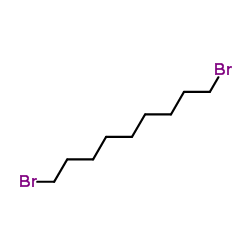Azelaic acid

Azelaic acid structure
|
Common Name | Azelaic acid | ||
|---|---|---|---|---|
| CAS Number | 123-99-9 | Molecular Weight | 188.221 | |
| Density | 1.1±0.1 g/cm3 | Boiling Point | 286 ºC (100 mmHg) | |
| Molecular Formula | C9H16O4 | Melting Point | 98-103 ºC | |
| MSDS | Chinese USA | Flash Point | 215 ºC | |
| Symbol |

GHS07 |
Signal Word | Warning | |
Use of Azelaic acidAzelaic acid is an organic compound produced by the ozonolysis of oleic acid; component of a number of hair and skin conditioners. |
| Name | azelaic acid |
|---|---|
| Synonym | More Synonyms |
| Description | Azelaic acid is an organic compound produced by the ozonolysis of oleic acid; component of a number of hair and skin conditioners. |
|---|---|
| Related Catalog | |
| Target |
Human Endogenous Metabolite |
| References |
[1]. Jung HW, et al. Priming in systemic plant immunity. Science. 2009 Apr 3;324(5923):89-91. |
| Density | 1.1±0.1 g/cm3 |
|---|---|
| Boiling Point | 286 ºC (100 mmHg) |
| Melting Point | 98-103 ºC |
| Molecular Formula | C9H16O4 |
| Molecular Weight | 188.221 |
| Flash Point | 215 ºC |
| Exact Mass | 188.104858 |
| PSA | 74.60000 |
| LogP | 1.33 |
| Vapour density | 6.5 (vs air) |
| Vapour Pressure | 0.0±1.8 mmHg at 25°C |
| Index of Refraction | 1.475 |
| Stability | Stable. Combustible. Incompatible with bases, strong oxidizing agents. Readily biodegrades in soil and water with >70% DOC reduction after 28 days. |
| Water Solubility | 2.4 g/L (20 ºC) |
CHEMICAL IDENTIFICATION
HEALTH HAZARD DATAACUTE TOXICITY DATA
|
| Symbol |

GHS07 |
|---|---|
| Signal Word | Warning |
| Hazard Statements | H319 |
| Precautionary Statements | P305 + P351 + P338 |
| Personal Protective Equipment | Eyeshields;Gloves;type N95 (US);type P1 (EN143) respirator filter |
| Hazard Codes | Xi: Irritant; |
| Risk Phrases | R36/37/38 |
| Safety Phrases | S24/25 |
| RIDADR | NONH for all modes of transport |
| WGK Germany | 1 |
| RTECS | CM1980000 |
| HS Code | 2917139000 |
| Precursor 10 | |
|---|---|
| DownStream 10 | |
| HS Code | 2917139000 |
|---|---|
| Summary | 2917139000 azelaic acid, sebacic acid, their salts and esters VAT:17.0% Tax rebate rate:9.0% Supervision conditions:none MFN tariff:6.5% General tariff:30.0% |
|
Translating clinical findings into knowledge in drug safety evaluation--drug induced liver injury prediction system (DILIps).
J. Sci. Ind. Res. 65(10) , 808, (2006) Drug-induced liver injury (DILI) is a significant concern in drug development due to the poor concordance between preclinical and clinical findings of liver toxicity. We hypothesized that the DILI typ... |
|
|
Physiology and pathophysiology of organic acids in cerebrospinal fluid.
J. Inherit. Metab. Dis. 16(4) , 648-69, (1993) Concentrations of organic acids in cerebrospinal fluid (CSF) appear to be directly dependent upon their rate of production in the brain. There is evidence that the net release of short-chain monocarbo... |
|
|
Age-related reference values for urinary organic acids in a healthy Turkish pediatric population.
Clin. Chem. 40(6) , 862-6, (1994) Organic acid concentrations were quantified by gas chromatography and the individual acids identified by mass spectrometry in urine specimens from a healthy Turkish pediatric population of ages 2 days... |
| Skinoren |
| AZALEIC ACID |
| Azelaate |
| 3,4-Dimethoxybenzaldehyde |
| Nonanedioic acid |
| Azelaic acid |
| UNII-F2VW3D43YT |
| AZELAIC ACID/NONANEDIOIC ACID |
| Barasertib |
| AZELAIC ACID FOR SYNTHESIS |
| INH 34 |
| Azelex |
| Azelaicacid |
| Finaceae |
| lepargylic acid |
| 1,7-HEPTANE DICARBONIC ACID |
| 1,7-HEPTANEDICARBOXYLIC |
| AZD1152-HQPA |
| Azelainic acid |
| HEPTANE-1,7-DICARBOXYLIC ACID |
| Azalaic Acid |
| AZELAIC ACID( MICRONIZED ) |
| EINECS 204-669-1 |
| anchoic acid |
| 1,7-Heptanedicarboxylic acid |
| MFCD00004432 |
 CAS#:112-80-1
CAS#:112-80-1 CAS#:112-62-9
CAS#:112-62-9 CAS#:137-21-3
CAS#:137-21-3 CAS#:24753-49-9
CAS#:24753-49-9 CAS#:120-87-6
CAS#:120-87-6 CAS#:37056-34-1
CAS#:37056-34-1 CAS#:14436-32-9
CAS#:14436-32-9 CAS#:141-22-0
CAS#:141-22-0 CAS#:373-49-9
CAS#:373-49-9 CAS#:112-79-8
CAS#:112-79-8 CAS#:105-03-3
CAS#:105-03-3 CAS#:106664-96-4
CAS#:106664-96-4 CAS#:3788-56-5
CAS#:3788-56-5 CAS#:4080-95-9
CAS#:4080-95-9 CAS#:593-49-7
CAS#:593-49-7 CAS#:4549-33-1
CAS#:4549-33-1 CAS#:4549-31-9
CAS#:4549-31-9 CAS#:34957-73-8
CAS#:34957-73-8 CAS#:3937-56-2
CAS#:3937-56-2 CAS#:502-49-8
CAS#:502-49-8
